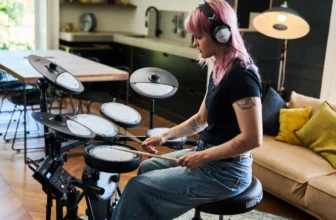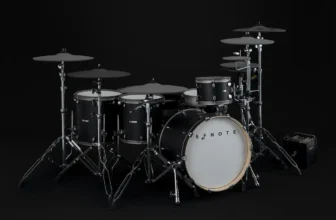

College music audition season is just around the corner, so if you have not already, it may be time to think about what you are going to prepare to wow the recruiters (most likely your future directors).
This season usually begins in late January/early February and ends by the middle of April. While the outcome of the audition depends on your playing, it also depends on the pieces you choose.
A great audition can determine the amount of money you receive to fund your education, which is why this is extremely important to consider.
For percussionists, at least, most colleges will ask you to bring two contrasting pieces. It would probably be best to prepare a mallet solo and a snare solo of some sort.
However, if you decide to prepare two mallet solos, be ready to exhibit skill in snare rudiments as your examiners may ask for it on the spot. You may also need to sight-read and play scales.
For example, I brought two mallet pieces to an audition. After playing them, I was asked to buzz roll on snare, sight-read a snare piece, sight-read a mallet piece, and play two scales of my choice on marimba.
What to Look For in a Marimba Solo
When choosing a piece, I have identified three things to look for:
Difficulty Level
Solos are usually ranked on a scale of difficulty, depending on the source you order the music from.
For some, they are ranked by number, from 1-10, and others (usually for district and state contest) are classified by letter with “A” being the greatest difficulty.
A majority of the rankings by number are grade 6 or less. The difficulty range you want to stay in to still be impressive but play well would be between 4-6, or A-B equivalent.
Style
Think about the style of music you play best.
- Do you play songs well that have a long of dynamic changes or speed changes?
- Do you prefer when songs have a steady rhythm?
- Would you rather be able to interpret a flow for yourself based on what is written?
- Do you prefer to listen to and play slow, soft songs or songs that are fast and loud?
These are things to think about because you are going to be hearing yourself play these songs over the next few months, and you don’t want to end up hating the piece you picked.
If you pick a style that syncs with your musical personality well, your strengths will be showcased during the audition.
Uniqueness
This is a little harder to test for. It is not the end of the world if you bring a conventional solo as long as you play it well.
However, playing something that your judge has not heard five times already that day may help you to stand out when they decide your scholarship status.
It will also give you more of a buffer if they are comparing you to another potential student; if they did not play the same solo, you wouldn’t have as much competition as if they played the same solo better than you did.
I don’t know everything that goes through a judge’s mind, but any boost you can give yourself will help.
Top 10 Marimba Solos for College Auditions
Disclaimer: Links throughout the article are affiliated — some with Sheet Music Plus and some with Amazon. As an Amazon Associate, I earn from qualifying purchases.
I am done explaining the process, so let’s get into the list! (Disclaimer: This is my opinion from experience. If there is a solo that you think should be on this list that I missed, I apologize).
1) Ghost Garden – Adam Hopper
- Difficulty: B (Medium/Easy)
- Speed: 176 BPM
- Mallet Usage: 4 Mallets
- Marimba Size: 4.3 Octave
- Length: 4:45
Ghost Garden is a beautiful piece, in my opinion. It has a lot of dynamic shifts, which, if done correctly, can be very impressive to college recruiters.
This is a four-mallet piece, and there is quite a bit of independent mallet usage. However, it is mainly made up of 8th notes at 176 BPM, and the 4 mallet patterns are not very complicated, so with practice, it should not be too much to handle.
There is a more complicated spot in the middle of the song, but it would just take some muscle memory and practice to get through if you’re a little newer to 4-mallet percussion.
If you pay attention to the dynamics and movement of the rhythms, Ghost Garden can be an impressive piece.
2) A Cricket Sang and Set the Sun – Blake Tyson
- Difficulty: A (Medium/Hard)
- Speed: 110 BPM
- Mallet Usage: 4 Mallets
- Marimba Size: 4.3 Octave
- Length: 5:00
This is a piece I played for my college audition. It is beautiful, and if you like interpreting songs for yourself, this one is perfect for you.
There is a lot of room to shift the speed and dynamics to make the music flow nicely. It is mainly made up of 16th notes moving at 110 BPM, so it is not too fast. However, the sticking patterns are pretty intricate at times, so it takes a bit of practice to get correct.
I would highly recommend this one for a college audition piece because it can really show off your musicianship and your capabilities as a player.
3) Rain Dance – Alice Gomez
- Difficulty: B (Medium/Easy)
- Speed: 92 BPM
- Mallet Usage: 4 Mallets
- Marimba Size: 4.0 Octave
- Length: 5:15
Rain Dance is a repetitive but fun piece to play. It has some syncopation and a couple tough spots to figure out, but overall it is a pretty straight forward song.
It is a four-mallet piece that is pretty easy to pick up, and mainly uses double stops rather than independent strokes.
The majority of any separate mallet usage is with the left hand, but it is not very complicated. It is a catchy song to listen to, so learning it will be easier if you understand how it sounds in a recording.
I think a judge would be very impressed with this piece if you pay attention to the few dynamic shifts. If you prefer songs that have a steady rhythm and a vibrant pattern, this one is definitely for you. I recommend it if you are primarily a drummer.
4) Rotation I – Eric Sammut
- Difficulty: A (Medium/Hard)
- Speed: 100 BPM
- Mallet Usage: 4 Mallets
- Marimba Size: 4.3 Octave
- Length: 2:40
Okay, I debated whether I should add this to the list or not. It is a pretty complicated solo to learn, but if you enjoy a challenge, this is for you.
If you can play it well, it would be very impressive to judges. It is a bit complicated to find a good flow at times because there are some atypical chord progressions.
However, this could be to your benefit because it is unique. Someone interested in playing this solo should have reasonable control over the four-mallet technique, so this is not for someone new to using four mallets.
As usual, finding an excellent dynamic balance will make all the difference with this piece. If you are looking for something a little more “typical” of a marimba solo, you may want to listen to Rotation II by Eric Sammut as well.
5) Land – Takatsugu Muramatsu
- Difficulty: A (Medium)
- Speed: Rubato
- Mallet Usage: 4 Mallets
- Marimba Size: 5 Octave
- Length: 2:40 (depends on the tempo you decide on)
Land is a beautiful solo, and it would be a great audition piece. It has a lot of room for interpretation for speed and dynamic shifts, so you can make it as beautiful as you want to.
The tempo is written as rubato, meaning for the player to interpret a good pace for themselves. It is a more advanced piece than most of the solos in this list; you must have a good handle on single independent mallet usage.
Something to keep in mind is the fact that it was written for a 5-octave marimba, so you need to make sure you have one available to practice on and one to play your actual audition on.
It would be wise to email the colleges you are auditioning at to check if they have a 5-octave available before attempting this piece. Land is a popular marimba solo, but you can make it your own and create a unique element with your personal style. This would make an excellent opportunity to exemplify your musicianship.
6) Strive to be Happy – Ivan Trevino
- Difficulty: A (Medium/Hard)
- Speed: 108 BPM
- Mallet Usage: 4 Mallets
- Marimba Size: 4.3 Octave
- Length: 4:00-4:30
Strive to be Happy can be a very emotionally moving piece. This is another great one to show the recruiters your musicianship.
It requires skillful four-mallet usage, but working through it should not be too difficult if you have some experience with the technique.
There is a lot of single independent usage, but it is definitely worth a try, no matter your experience level. It is very repetitive, so once you learn the first few parts of the song, learning the rest should not be a challenge.
7) Yellow After the Rain – Mitchell Peters
- Difficulty: A (Medium)
- Speed: 126 BPM
- Mallet Usage: 4 Mallets
- Marimba Size: 4.3 Octave
- Length: 3:00
Yellow After the Rain is a perfect solo for beginning/intermediate four-mallet players. It has a lot of independent mallet usage, but it is more about keeping a steady 16th note rhythm across the mallets.
If you keep the tempo steady, it should be simple enough to master. The pattern may seem complicated at first, but it is just 1-3-2-4, and if you take it slowly at first, it makes it easier to work up to the written tempo.
This solo is very common among mallet players, so its lack of uniqueness may be something for you to consider.
There is plenty of dynamic shift to accentuate your control of dynamics, but the speed stays the same, so if you are not comfortable with a lot of speed changes, this may be the right choice for you.
8) Anubis – Blake Tyson
- Difficulty: A (Medium/Hard)
- Speed: 80 BPM
- Mallet Usage: 4 Mallets
- Marimba Size: 5 Octave
- Length: 3:50
Anubis is a dark and intense song, so if that is your style, this is perfect for you. This piece is excellent for intermediate four-mallet players.
It was written to be played on a 5-octave marimba, so again, it would be wise to email the colleges you are auditioning at to check if they have a 5- octave available before attempting this piece.
The dynamics in this song add so much to the intensity and emotion for the audience. If you decide to play Anubis, pay close attention to the dynamics.
Reasonable dynamic control is always your friend. Building up the volume from soft entrances will help express the eerie feel of the song.
This would be great for showing off your dynamic control and ability to project emotion from your playing; this is something recruiters will love.
9) Etude in D Minor – Alice Gomez
- Difficulty: B (Medium/Easy)
- Speed: 92 BPM
- Mallet Usage: 3/4 Mallets
- Marimba Size: 4.3 Octave
- Length: 6:00
Etude in D minor is very fun to play. It takes some effort to get used to the rhythms, but once you figure it out, it is delightful to continue.
It is unique because it can actually be played with only three mallets instead of four, and there is a section to play on the edges of the keys with the mallet shafts.
This piece is definitely not your typical marimba solo. However, it is not very difficult to learn, so without good dynamic and speed control, it may not be as impressive for a college audition as some of the other pieces in this list.
10) April Sky – Chin Cheng Lin
- Difficulty: B (Medium/Easy)
- Speed: 115 BPM
- Mallet Usage: 4 Mallets
- Marimba Size: 4.3 Octave
- Length: 5:30-6:00
April Sky has a slow beginning, but once it picks up, it is beautiful and melodic. It is suitable for beginner to intermediate level four-mallet players.
It is more accessible than the rest of the solos in this list, so it may not be awe-inspiring unless you use the dynamics and speed to your advantage and make it emotional.
It is vital for any piece of music, to interpret it for yourself and make it unique (within reason).
Although this song is at a more manageable level, it still requires some skill with four mallets. Overall, it would always be a perfect choice for a college audition, you just need to make sure you play the song to its full potential.
Thank you so much for reading this, and I hope this list is helpful to your decision! Good luck!














man these are way too easy, we have a freshman in our high school playing strive to be happy her freshman year and that’s normal, I played ghost garden my freshman year, now I’m playing etude in e minor by Pius Cheung as a junior and my junior/sophomore friends are playing Wind Sketch (Abe) and Virginia Tate (Smadbeck), that’s what really should be on this list, I can tell you guys are drummers that have barely any experience holding 4 mallets, sorry but it’s the facts
The article title isn’t “best marimba solos for junior and senior recitals.” It’s aimed at picking solos for auditioning as an undergraduate. Not everyone auditioning has a strong background in four-mallet percussion. I wouldn’t list Merlin or Ultimatum I here; I also didn’t write this piece, rather a contributor did who is currently at university studying percussion having just auditioned and was recently accepted the past year.
Thats definitely just the school you have the chance to go to. Where I go, our program is a disaster, I can’t find a private lesson teacher in the area, and I’m in the process of self teaching myself 4 mallets off youtube. Percussion instruction really does depend on the school you go to. If you’re lucky enough to live in an area with a good music program, you do well.
I’m honestly sad the only 4 octave solo on this list is Rain Dance… I’m really struggling to find 4 octave solos
Yes, that’s going to be difficult, I’d imagine. Solos for 4.3 and 5-octave marimbas are far more common.
I found a couple threads—you may have already found there, but: https://www.reddit.com/r/Marimba/comments/bvivue/looking_for_4_octave_marimba_solos/
https://www.reddit.com/r/percussion/comments/gismzq/anyone_have_any_4_not_43_octave_marimba_solos/
https://www.reddit.com/r/percussion/comments/emjuic/4_octave_marimba/
Thank you for putting the time and effort into making this article, it was very helpful!
It’s fascinating to me, coming to this instrument in my sixth decade, how non-musical the rep for this is.
It sounds like a lot of rehashed 1980’s minimalist rep, where the patterns never stop, but there is preciously little LINE. Granted, it’s a percussion instrument, but so is the piano! “April Sky” is about the only choice I would inflict on my colleagues (I’m a university Music Prof) if we were to have ‘marimbists’ coming to do auditions for undergrad work. I laughed when I first ordered mallets from a vendor, and he equated most marimba playing today to sounding like someone hitting tuned milk bottles, but now I see what he meant. Theodor Milkov is about the only one out there that is doing this, IMHO. thanks for the choices, but there have to be better options out there.